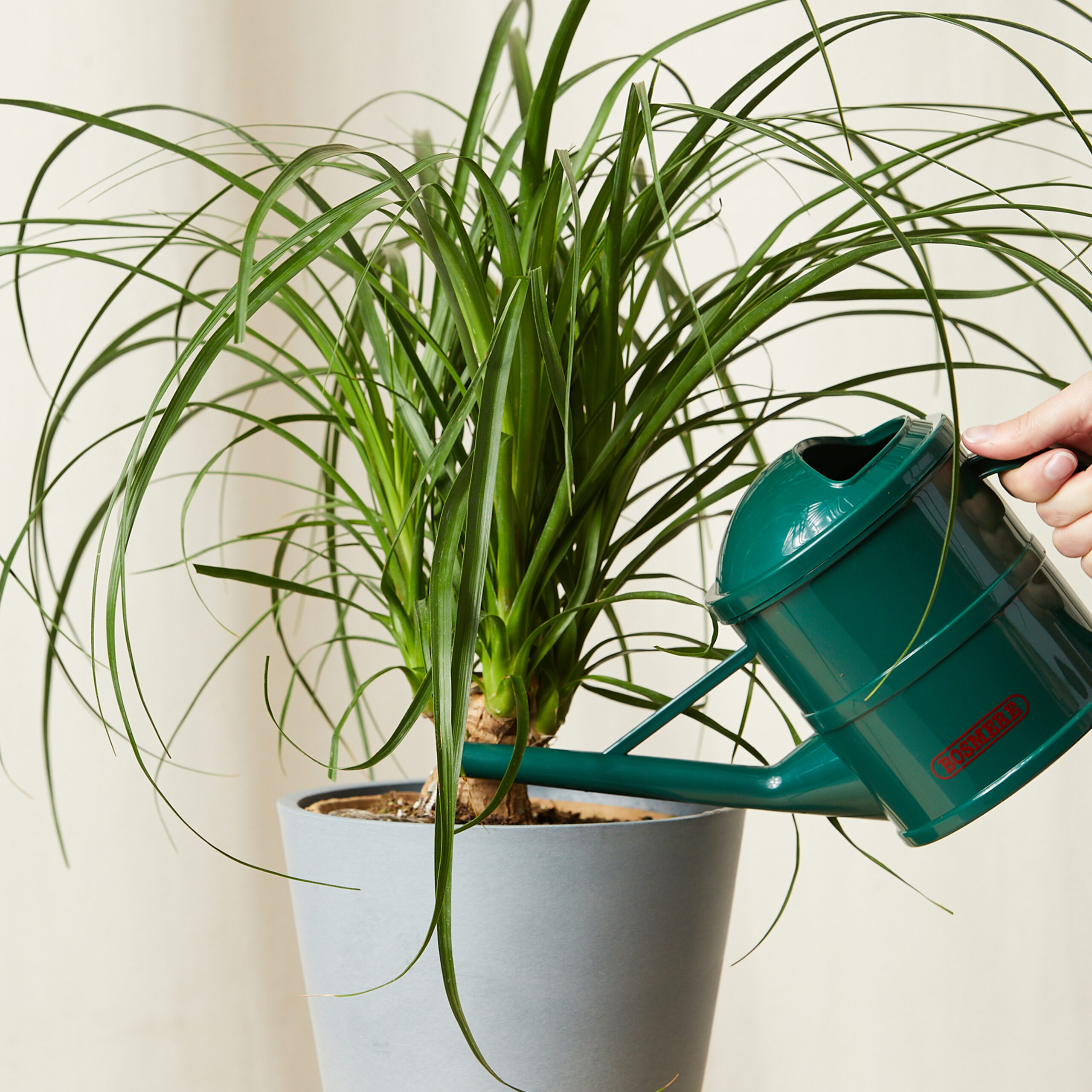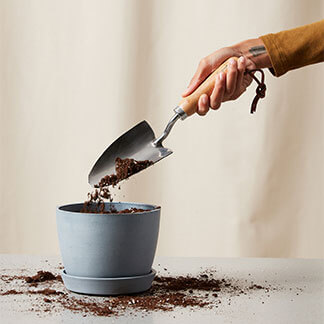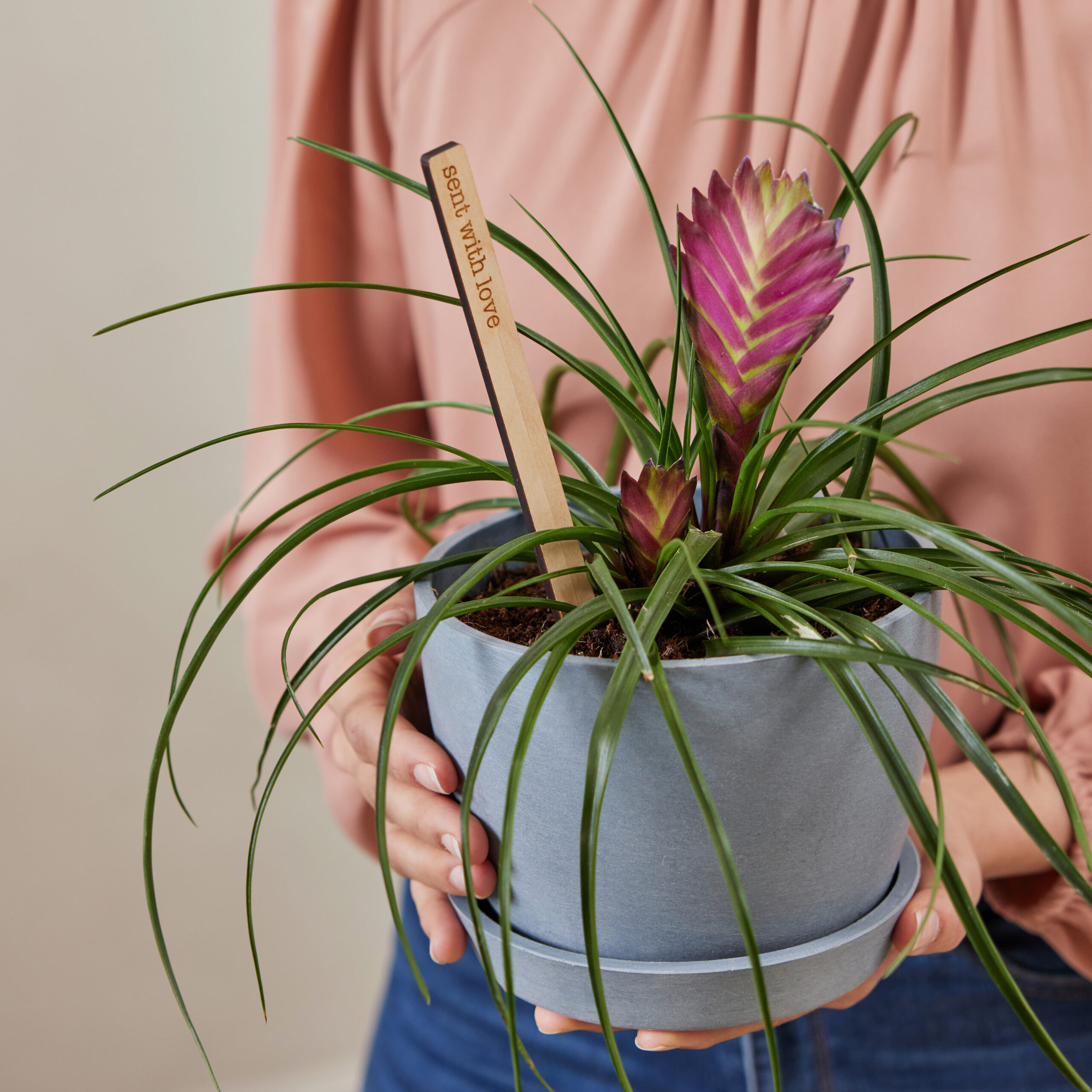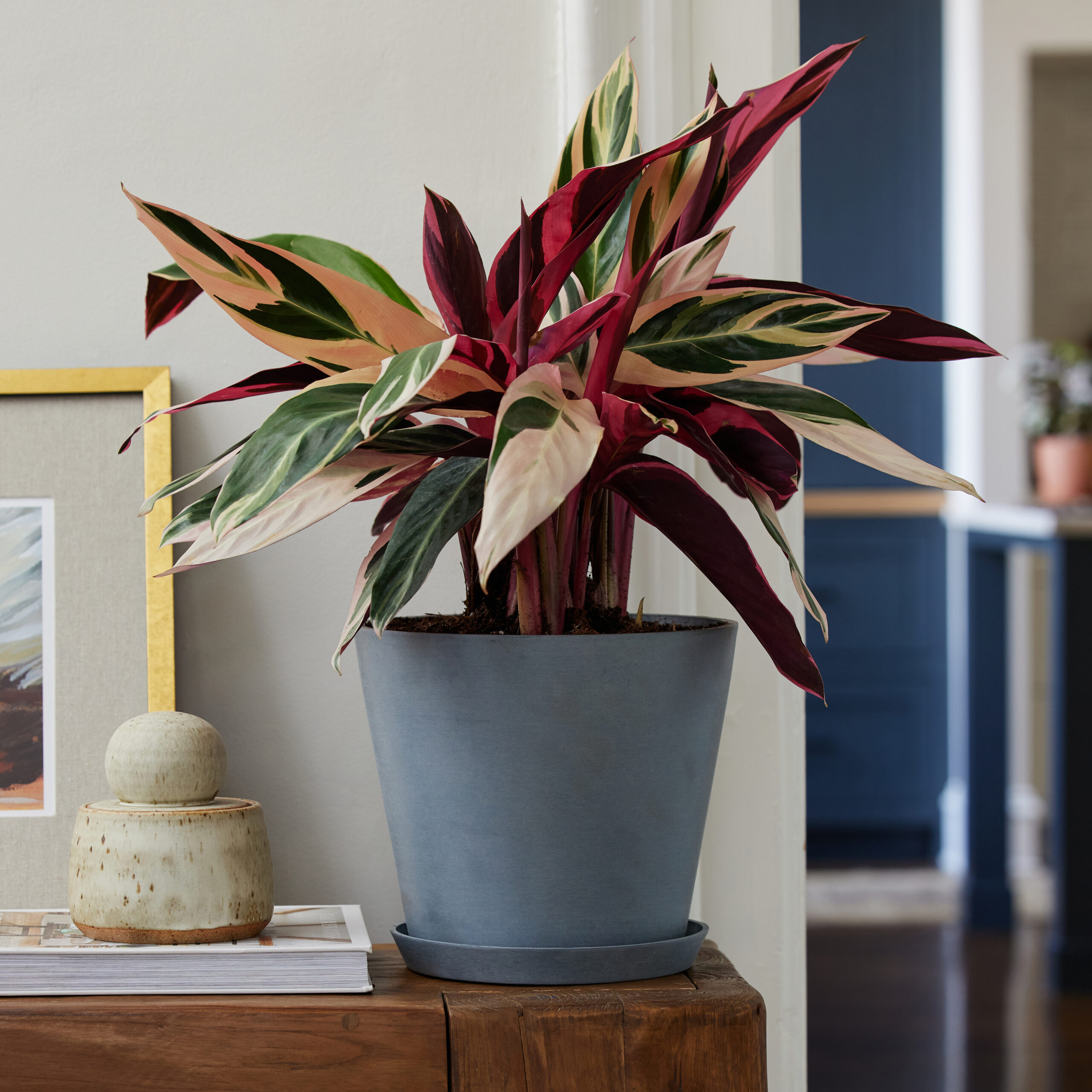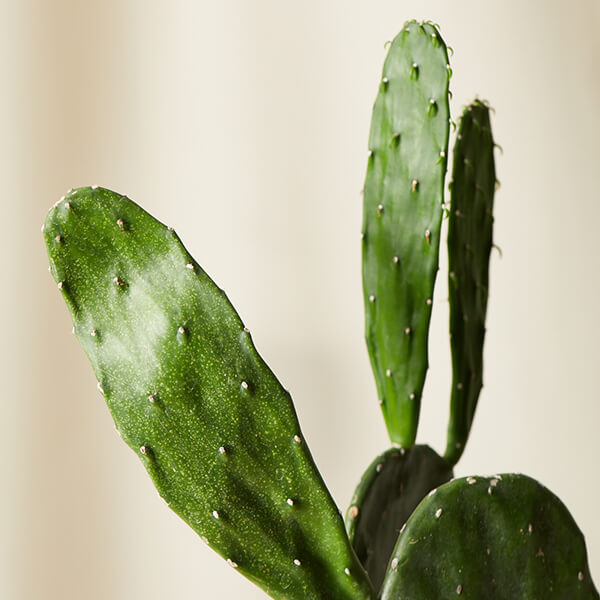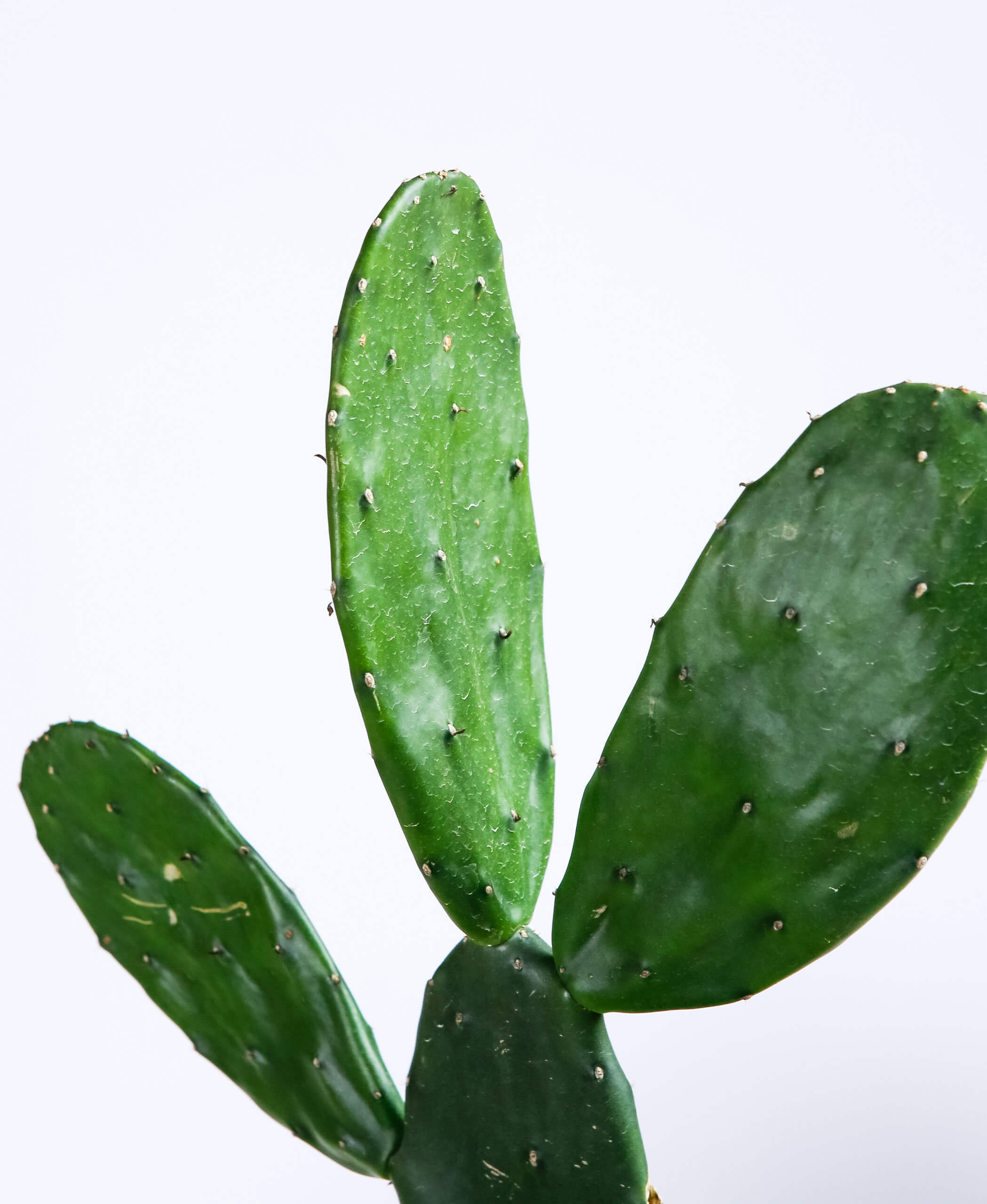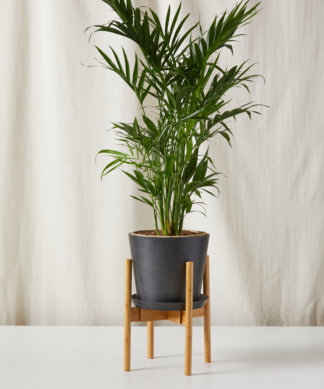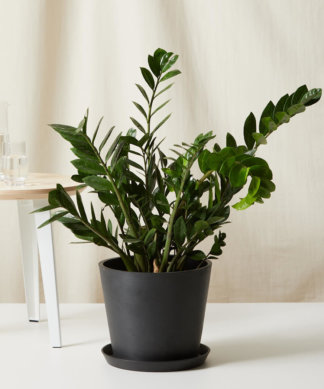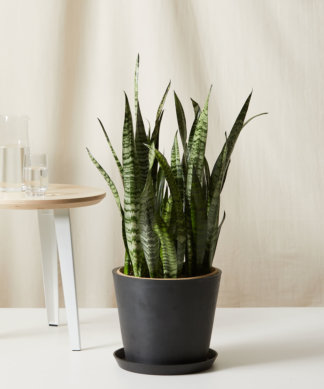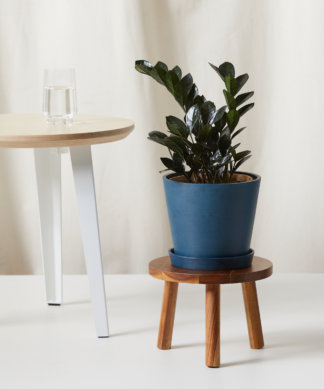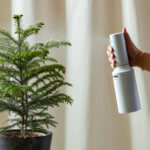How to care for your Cactus
Use these instructions to care for a Cactus. This guide will tell you how to water a Cactus; its light, temperature, humidity preferences and any additional care it might need to help it grow.
Bishop's Cap Cactus
Your Bishop’s Cap Cactus needs as much bright light to full sunlight as it can possibly get.
Water only when the soil is completely dry. Water until liquid flows through the drainage hole at the bottom of the pot and discard any water that has accumulated in the saucer.
Your Bishop’s Cap Cactus requires no additional humidity, and will thrive in dry environments.
Your Bishop’s Cap Cactus prefers temperatures between 55-90 degrees. Keep away from heating or cooling vents, fans, heaters, and air conditioning units that cause fluctuating temperatures.
Before applying any type of plant food, make sure the soil is already damp-never apply to dry soil. Your Bishop’s Cap Cactus requires fertilizer once in the spring and once in the summer. Apply an all-purpose, liquid plant food diluted to half strength. Do not fertilize your cactus in the fall or winter months when growth naturally slows.
Non-toxic to pets and children.
Some plants are more green in color, and some have a white flecked coating- this is a natural protective response from the cacti! It may fleck off naturally, but no need to take it off yourself.
Bullwinkle Cactus
Your Bullwinkle Cactus needs as much bright light to full sunlight as it can possibly get.
Water only when the soil is completely dry. Water until liquid flows through the drainage hole at the bottom of the pot and discard any water that has accumulated in the saucer.
Your Bullwinkle Cactus requires no additional humidity and thrives in dry environments.
Keep the room temperature between 55-90 degrees. Keep your Bullwinkle Cactus away from heating or cooling vents, fans, heaters, and air conditioning units that cause fluctuating temperatures.
Before applying any type of plant food, make sure the soil is already damp-never apply to dry soil. Your Bullwinkle Cactus requires fertilizer once in the spring and once in the summer. Apply an all-purpose, liquid plant food diluted to half strength.
When handling your Bullwinkle cactus, use gloves, gentle tongs, or wrap the plant in cloth so the spines cannot puncture your skin.
Non-toxic to pets and children, but watch out for the spines!
Dwarf Chin Cactus
Your Cactus prefers bright light to full sun.
Water only when the soil is completely dry. Water until liquid flows through the drainage hole at the bottom of the pot and discard any water that has accumulated in the saucer.
Your Dwarf Chin Cactus requires no additional humidity and will thrive in dry environments.
Your Dwarf Chin Cactus prefers temperatures between 55-90 degrees. Keep away from heating or cooling vents, fans, heaters, and air conditioning units that cause fluctuating temperatures.
Before applying any type of plant food, make sure the soil is already damp—never apply to dry soil. Your Dwarf Chin Cactus requires fertilizer once in the spring and once in the summer. Apply an all-purpose liquid plant food diluted to half strength. Do not fertilize your cactus in the fall or winter months when growth naturally slows.
Non-toxic to pets and children. However, beware of the spines and thorns!
When handling your Dwarf Chin Cactus, it is suggested to use gloves or wrap the plant in a fabric that the spines cannot puncture.
Easter Lily Cactus
Your cactus needs bright direct light. This means a spot that gets 6 or more hours of direct sun per day.
Water your cactus when the volume of soil is 100% dry. Water thoroughly until it flows out of the drainage hole. Discard excess water to discourage root rot.
Cacti do well in dry to average household humidity and prefer dry air.
Your cactus prefers temperatures between 60-90°F.
Fertilize once in the spring and summer with a cactus or succulent fertilizer.
This plant is non-toxic to humans and pets if ingested but watch for thorns.
Be sure to wear gloves when handling or repotting as they have sharp spines. To encourage your cacti to bloom, make sure your plants are getting strong unobstructed direct light from a southern or western window. You can also place them outdoors in direct sun as long as temperatures allow.
Emerald Ripple Cactus
Your Emerald Ripple Cactus needs as much bright light to full sunlight as it can possibly get. Make sure to acclimate if moving outside into the direct sunlight. In the winter, if possible, move it to a cooler spot with less light so it can go dormant and rest.
Water only when the soil is completely dry. Water until liquid flows through the drainage hole at the bottom of the pot and discard any water that has accumulated in the saucer.
This plant requires no additional humidity.
The Emerald Ripple Cactus prefers temperatures between 60-80 degrees.
Before applying any type of plant food, make sure the soil is already damp–never apply to dry soil. The Emerald Ripple Cactus requires fertilizer once in the spring and once in the summer. Apply an all-purpose, liquid plant food diluted to ½ strength. Do not fertilize in the fall or winter when plant growth naturally slows.
Moderately toxic to pets and humans. Typically, ingestion will cause mouth and stomach irritation and possible vomiting.
During the hottest summer months, your Emerald Ripple will appreciate the extra sunlight it gets if you are able to put it outside on a terrace.
Fairy Castle Cactus
Your Fairy Castle Cactus needs as much sunlight or full sun as it can possibly get through the early spring and into late Fall. Turn it frequently so a new section faces the light, or it will begin to lean.
Water your Fairy Castle Cactus deeply and allow it to dry completely between waterings in the spring and summer. Always water near the base of the plant and try to keep the column of the plant dry. Your Fairy Castle Cactus will not tolerate soggy soil. Make sure to empty the saucer of all standing water after each watering. During the late fall and winter, you can go up to 4 weeks without watering your cactus.
This plant requires no additional humidity.
Your Fairy Castle Cactus prefers temperatures between 60-80 degrees.
Before applying any type of plant food, make sure the soil is already damp–never apply to dry soil. The Fairy Castle Cactus requires fertilizer once in the spring and once in the summer. Apply an all-purpose, liquid plant food diluted to half the recommended strength. Do not fertilize in the fall or winter when plant growth naturally slows.
Your Cactus is moderately toxic to pets and humans. Typically, ingestion will cause mouth and stomach irritation and possible vomiting. Additionally, be sure to wear gloves when handling your cactus- the spines can be sharp!
During the summer months, your Fairy Castle Cactus will appreciate the extra sunlight it will get if you are able to place it outside in a sunny spot. Move it from inside to full sun over the course of 1-2 weeks to acclimate your cactus to the extra sunshine.
Fishbone Cactus
Your Fishbone Cactus prefers bright indirect light. It can also tolerate a couple of hours of direct sunlight but should not be placed in full sun. It also will not do well in low light situations.
Allow the soil to dry completely between watering, then water thoroughly until you see it flow from the bottom into the saucer. Always empty the saucer of any standing water.
Your Fishbone Cactus will benefit from additional humidity from misting or the use of a humidifier.
Your Fishbone Cactus will thrive in temperatures between 55-90 degrees. Keep away from heating or cooling vents, fans, heaters, and air conditioning units that cause fluctuating temperatures.
Before applying any fertilizer, make sure the soil is already damp–never apply to dry soil. Your Fishbone Cactus requires fertilizer once in the spring and once in the summer. Apply an all-purpose, liquid plant food diluted to half the recommended strength.
Non-toxic to pets and children.
Use gloves when handling and repotting your cactus, as the leaves have tiny hair-like structures that can cause discomfort and irritation when they come in contact with your skin.
Golden Barrel Cactus
Your Golden Barrel Cactus needs as much bright light to full sunlight as it can possibly get.
Water only when the soil is completely dry. Water until liquid flows through the drainage hole at the bottom of the pot and discard any water that has accumulated in the saucer.
Your Golden Barrel Cactus requires no additional humidity, and will thrive in dry environments.
Your Golden Barrel Cactus prefers temperatures between 55-90 degrees. Keep away from heating or cooling vents, fans, heaters, and air conditioning units that cause fluctuating temperatures.
Before applying any type of plant food, make sure the soil is already damp-never apply to dry soil. Your Golden Barrel Cactus requires fertilizer once in the spring and once in the summer. Apply an all-purpose, liquid plant food diluted to half strength. Do not fertilize your cactus in the fall or winter months when growth naturally slows.
Non-toxic to pets and children. However, beware of the spines and thorns!
When handling your Golden Barrel Cactus, it is suggested to use gloves or wrap the plant in a fabric that the spines cannot puncture.
Hedge cactus
Your Hedge Cactus needs as much sunlight or full sun as it can possibly get. Turn it frequently so a new section faces the light, or it will begin to lean. Make sure to acclimate if moving outside into the direct sunlight.
Water your Hedge Cactus deeply and allow it to dry completely between waterings in the spring and summertime. Always water near the base of the plant and try to keep the column of the plant dry. They will not tolerate wet, soggy soil or roots. Make sure to empty the saucer of all standing water. During the late fall and winter, you can go up to 4 weeks without watering your cactus.
This plant requires no additional humidity.
The Hedge Cactus prefers temperatures between 60-80 degrees.
Before applying any type of plant food, make sure the soil is already damp–never apply to dry soil. Your Hedge Cactus requires fertilizer once in the spring and once in the summer. Apply an all-purpose, liquid plant food diluted to ½ strength. Do not fertilize in the fall or winter when plant growth naturally slows.
During the hottest summer months, your Hedge Cactus will appreciate the extra sunlight it gets if you are able to put it outside on a terrace.
Hedge Cactus is non-toxic, but be sure to keep pets away and wear gloves when handling your cactus- the spines can be sharp!
Lady Finger Cactus
Your Lady Finger Cactus needs as much bright light to full sunlight as it can possibly get.
Water your cactus only when the soil is completely dry. Water until liquid flows through the drainage hole at the bottom of the pot and discard any water that has accumulated in the saucer.
Your Lady Finger Cactus requires no additional humidity, and will thrive in dry environments.
Your Lady Finger Cactus prefers temperatures between 55-90°F. Keep away from heating or cooling vents, fans, heaters, and air conditioning units that cause fluctuating temperatures.
Feed once in the spring and once in the summer with a fertilizer formulated for cacti. Do not fertilize in the fall or winter months when growth naturally slows. Always fertilize on moist soil, never dry, as it can burn the roots.
Non-toxic to pets and children. However, beware of the spines and thorns!
When handling your Lady Finger Cactus, it is suggested to use gloves or wrap the plant in a fabric that the spines cannot puncture.
Lantana Cactus
Your Lantana Cactus needs as much bright light to full sunlight as it can possibly get.
Water only when the soil is completely dry. Water until liquid flows through the drainage hole at the bottom of the pot and discard any water that has accumulated in the saucer.
Your Lantana Cactus requires no additional humidity and will thrive in dry environments.
Your Lantana Cactus prefers temperatures between 55-90 degrees. Keep away from heating or cooling vents, fans, heaters, and air conditioning units that cause fluctuating temperatures.
Before applying any type of plant food, make sure the soil is already damp—never apply to dry soil. Your Lantana Cactus requires fertilizer once in the spring and once in the summer. Apply an all-purpose liquid plant food diluted to half strength. Do not fertilize your cactus in the fall or winter months when growth naturally slows.
Non-toxic to pets and children. However, beware of the spines and thorns!
When handling your Lantana Cactus, it is suggested to use gloves or wrap the plant in a fabric that the spines cannot puncture.
Moon Cactus
The Moon Cactus needs bright direct light. This means a spot that gets 6 or more hours of direct sun per day, like an unobstructed southern or western window.
Water your cactus when the soil volume is 100% dry. Water thoroughly until it flows out of the drainage hole. Discard excess water to discourage root rot.
Cacti do well in dry to average household humidity.
Your cactus prefers temperatures between 60-90°F.
Fertilize once in the spring and once in the summer with a cactus or succulent fertilizer.
The Moon Cactus is considered pet friendly, but watch out for spikes.
Be sure to wear gloves when handling as the Moon Cactus has barbed bristles called glochids that can irritate the skin.
Old Lady Cactus
Your Old Lady Cactus needs as much bright light to full sunlight as it can possibly get.
Water only when the soil is completely dry. Water until liquid flows through the drainage hole at the bottom of the pot and discard any water that has accumulated in the saucer.
Your Old Lady Cactus requires no additional humidity, and will thrive in dry environments.
Your Old Lady Cactus prefers temperatures between 55-90 degrees. Keep away from heating or cooling vents, fans, heaters, and air conditioning units that cause fluctuating temperatures.
Before applying any type of plant food, make sure the soil is already damp-never apply to dry soil. Your Old Lady Cactus requires fertilizer once in the spring and once in the summer. Apply an all-purpose, liquid plant food diluted to half strength. Do not fertilize your cactus in the fall or winter months when growth naturally slows.
Non-toxic to pets and children. However, beware of the spines and thorns!
When handling your Old Lady Cactus, it is suggested to use gloves or wrap the plant in a fabric that the spines cannot puncture.
Old Man Cactus
Your cactus needs bright direct light. This means a spot that gets 6 or more hours of direct sun per day.
Water your cactus when the volume of soil is 100% dry. Water thoroughly until it flows out of the drainage hole. Discard excess water to discourage root rot.
Cacti do well in dry to average household humidity and prefer dry air.
Your cactus prefers temperatures between 60-90°F.
Fertilize once in the spring and summer with a cactus or succulent fertilizer.
This plant is non-toxic to humans and pets if ingested but watch for thorns.
Be sure to wear gloves when handling or repotting as they have sharp spines. To encourage your cacti to bloom, make sure your plants are getting strong unobstructed direct light from a southern or western window. You can also place them outdoors in direct sun as long as temperatures allow.
Peanut Cactus
Your Peanut Cactus needs as much bright light to full sunlight as it can possibly get.
Water your cactus only when the soil is completely dry. Water until liquid flows through the drainage hole at the bottom of the pot and discard any water that has accumulated in the saucer.
Your Peanut Cactus requires no additional humidity and will thrive in dry environments.
Your cactus prefers temperatures between 55-90°F. Keep away from heating or cooling vents, fans, heaters, and air conditioning units that cause fluctuating temperatures.
Feed once in the spring and once in the summer with a fertilizer formulated for cacti. Do not fertilize in the fall or winter months when growth naturally slows. Always fertilize on moist soil, never dry, as it can burn the roots.
Non-toxic to pets and children. However, beware of the spines and thorns!
Though the spines on this cactus are soft, it is still not recommended to touch them because they can still puncture the skin. When handling your cactus, it is suggested to use gloves or wrap the plant in a thick cloth.
Pincushion Cactus
Your cactus needs bright direct light. This means a spot that gets 6 or more hours of direct sun per day.
Water your cactus when the volume of soil is 100% dry. Water thoroughly until it flows out of the drainage hole. Discard excess water to discourage root rot.
Cacti do well in dry to average household humidity and prefer dry air.
Your cactus prefers temperatures between 60-90°F.
Fertilize once in the spring and summer with a cactus or succulent fertilizer.
This plant is non-toxic to humans and pets if ingested but watch for thorns.
Be sure to wear gloves when handling or repotting as they have sharp spines. To encourage your cacti to bloom, make sure your plants are getting strong unobstructed direct light from a southern or western window. You can also place them outdoors in direct sun as long as temperatures allow.
Prickly Pear Cactus
Your Prickly Pear Cactus prefers bright light to full sun.
Water only when the soil is completely dry. Water until liquid flows through the drainage hole at the bottom of the pot and discard any water that has accumulated in the saucer.
Your Prickly Pear requires no additional humidity.
Keep the room temperature between 55-90 degrees. Keep the Prickly Pear away from heating or cooling vents, fans, heaters, and air conditioning units that cause fluctuating temperatures. In the wintertime, try to place your Prickly Pear in a cooler setting with plenty of bright indirect sunlight.
Before applying any type of plant food, make sure the soil is already damp-never apply to dry soil. Your Prickly Pear Cactus requires fertilizer once in the spring and once in the summer. Apply an all-purpose, liquid plant food diluted to half strength. Do not fertilize your Prickly Pear in the fall or winter when plant growth naturally slows.
Non-toxic to pets and children. However, beware of the spines and thorns!
When handling a Prickly Pear, it is suggested to use gloves or wrap the plant in something that the spines cannot puncture the skin.
Red Balloon Barrel Cactus
Your Red Balloon Cactus needs as much bright light to full sunlight as it can possibly get.
Water only when the soil is completely dry. Water until liquid flows through the drainage hole at the bottom of the pot and discard any water that has accumulated in the saucer.
Your Red Balloon Barrel Cactus requires no additional humidity, and will thrive in dry environments.
Your Red Balloon Barrel Cactus prefers temperatures between 55-90 degrees. Keep away from heating or cooling vents, fans, heaters, and air conditioning units that cause fluctuating temperatures.
Before applying any type of plant food, make sure the soil is already damp-never apply to dry soil. Your Red Balloon Barrel Cactus requires fertilizer once in the spring and once in the summer. Apply an all-purpose, liquid plant food diluted to half strength. Do not fertilize your cactus in the fall or winter months when growth naturally slows.
Non-toxic to pets and children. However, beware of the spines and thorns!
When handling your Red Balloon Barrel Cactus, it is suggested to use gloves or wrap the plant in a fabric that the spines cannot puncture.
Torch Cactus
Your Torch Cactus needs as much sunlight or full sun as it can possibly get. Turn it frequently so a new section faces the light, or it will begin to lean. Make sure to acclimate if moving outside into the direct sunlight.
Water your Torch Cactus deeply and allow it to dry completely between waterings in the spring and summertime. Always water near the base of the plant and try to keep the column of the plant dry. They will not tolerate wet, soggy soil or roots. Make sure to empty the saucer of all standing water. During the late fall and winter, you can go up to 4 weeks without watering your cactus.
This plant requires no additional humidity.
Your Torch Cactus prefers temperatures between 60-80 degrees.
Before applying any type of plant food, make sure the soil is already damp-never apply to dry soil. Your Candelabra Cactus requires fertilizer once in the spring and once in the summer. Apply an all-purpose, liquid plant food diluted to half strength. Do not fertilize your Prickly Pear in the fall or winter when plant growth naturally slows.
Moderately toxic to pets and humans. Typically, ingestion will cause mouth and stomach irritation and possible vomiting.
During the hottest, summer months, your Torch Cactus will appreciate the extra sunlight it gets if you are able to put it outside on a terrace.
Zygo Cactus
Your Zygo Cactus prefers bright indirect light and will not do well in low light. Extended periods of direct sunlight may scorch the foliage.
Water when 25-50% of the soil volume is dry. Water until liquid flowers through the drainage hole and discard any water that accumulates in the saucer.
Your Zygo Cactus does best in above-average household humidity. Use a pebble tray, group with other plants, or place a humidifier nearby.
Your Zygo Cactus prefers temperatures between 55-90°F.
Feed once in the spring and once in the summer with a cactus or succulent fertilizer. Never apply fertilizer to dry soil.
This plant is considered non-toxic and pet-friendly.
Cut off spent blooms using sharp clean shears so your plant can redirect its energy toward new growth. Once flowering has finished in the winter, place your plant in a cool, dim area like a basement. Water infrequently during its dormancy. In the spring, move your plant back to a warm bright area, water it, and continue to care for the plant as normal once it has perked back up.


